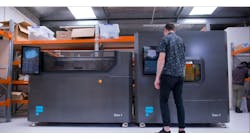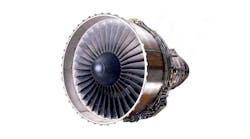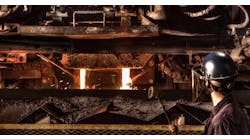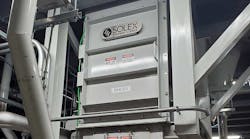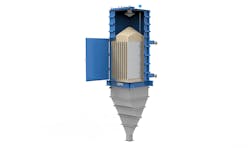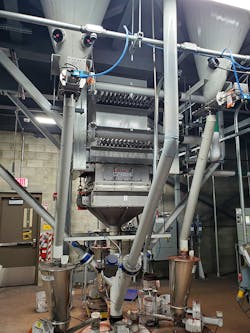In September 2022, the U.S. Occupational Safety and Health Administration announced it would be stepping up enforcement of its existing workplace health safety standards – specifically, high-emphasis hazards such as exposure to crystalline silica dust in the workplace.
This enhanced oversight is forcing metalcasters to take a closer look at the technologies now in place in their foundries, and deciding whether the current capabilities for addressing airborne particulates are either helping or hurting their efforts to meet those regulations.
Previously, we addressed how some direct-contact temperature control methods, such as foundry sand fluid-bed heaters and coolers, are contributing to the challenge of mitigating personnel exposure to respirable crystalline silica in the workplace. Here, our objective is to examine how indirect sand conditioning solutions such as plate-based moving-bed heat exchangers (MBHEs) provide a more effective answer not only for mitigating silica exposure but also for addressing a developing need for better energy-consumption management.
How it works
MBHEs that use vertical plate technology are derived from traditional plate heat exchangers (PHEs), which are still commonplace in numerous process industries. While PHEs allow heat transfer from one fluid (liquid or gas) to another fluid, MBHEs that use vertical plate technology allow indirect heat transfer between solids and fluids.
In an MBHE, the material enters the unit and flows by gravity through banks of parallel vertical stainless-steel plates. A heat transfer fluid – typically water – passes through the plates to heat or cool the material by conduction.
A discharge feeder in place at the exit of the MBHE controls the rate of flow through the heat exchanger while providing uniform mass drawdown. Thermal modeling calculations using material property data ensures precise discharge temperature control.This passive, indirect form of heat transfer – the flow velocity typically is less than 0.3 m/min — means MBHEs do not contribute to any additional dust formation or degradation of sand quality. By reducing the generation of dust and mitigating the chance of dust egress, moving bed heat exchangers also lessen the loads on existing baghouses and dust collectors.
In contrast, direct-contact methods such as fluidized beds rely on ambient air drawn into the system using high-horsepower fans. The air is blown through the sand – and while this provides an effective way to condition the sand, it is a highly agitating process that leads to abrasion, attrition, and the formation of large quantities of dust.
Fluidized beds also require blowers, ducting, and associated air-handling and -cleaning equipment to circulate the air and then clean it before it can be discharged to the environment. MBHEs do not use air, meaning plant operators can realize significant savings in energy requirements along with a reduced potential to generate dust while cooling the sand.
MBHEs in practice
In 2022, Solex Thermal Science worked with Benton Foundry as it began an expansion program aimed at to doubling its coremaking capacity from 5,000 to 10,000 tons of cores annually.
The northeastern Pennsylvania gray and ductile iron foundry, which has been in continuous operation since the mid-1800s, was using a fluidized bed to condition the sand it uses to manufacture cores for valves, flanges, pipe fittings and auto, truck and tractor parts.
The cast house required an updated air-quality control capability that would match the increased throughput while also offering tighter process controls.
Benton selected Solex to develop a customized, pillow-plate MBHE that is rated for an average of 8,000 lbs/hr up to a maximum of 14,000 lbs/hr. With accurate sand discharge temperatures guaranteed, the new MBHE also minimizes energy consumption.
Commissioned in mid-2022, the Solex solution has proven to be a “unit of choice,” according to Tim Brown, vice president at Benton Foundry.
Brown noted that the MBHE creates near-zero shear forces when conditioning the sand and that, due to its gentle handling of the sand, does not fracture or breakdown the grains. This has made it a good fit with several recent significant dust-control and energy-management initiatives that earned Benton Foundry the American Foundry Society’s 2022 Green Foundry Sustainability & Stakeholder Engagement Award. For example, the foundry also installed new robotic grinders and cleaning machines to automate the finishing process for castings, while also mitigating additional dust exposure to foundry workers.
More points in favor
Brown noted that the new MBHE also helped Benton realize some valuable energy savings. Because the system does not require high-horsepower air-handling and -cleaning equipment, he estimated energy consumption is nearly half the requirements of the previous unit, with savings projected at around 100,000 kWh annually.
“It is definitely saving us money through reduced energy consumption, but also fewer repairs and less maintenance because it has fewer moving parts,” Brown said.
OSHA’s heightened enforcement of regulations covering crystalline-silica dust exposure in the workplace means many industries in the U.S. will re-evaluate the performance and effectiveness of their technologies for controlling the particulates in the workplace atmosphere. Metalcasting operations are certainly among these.
This means that systems based on today’s technologies will need to do more, to perform better. In the case of sand conditioning, it is not enough just to provide accurate temperature control. It’s also important to address emerging needs, like reducing energy consumption and containing dust emissions. How that’s accomplished has become increasingly important.
Plate-based moving bed heat exchangers provide that opportunity for metalcasters to maintain tighter process controls while also protecting workers from crystalline silica dust particles – and to realize significant energy savings along the way.
Scott Harris is Regional Director, Americas for Solex Thermal Science, a developer of indirect heat exchange technology for the heating, cooling and drying of free-flowing granular materials.



